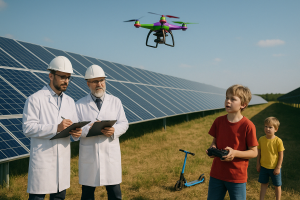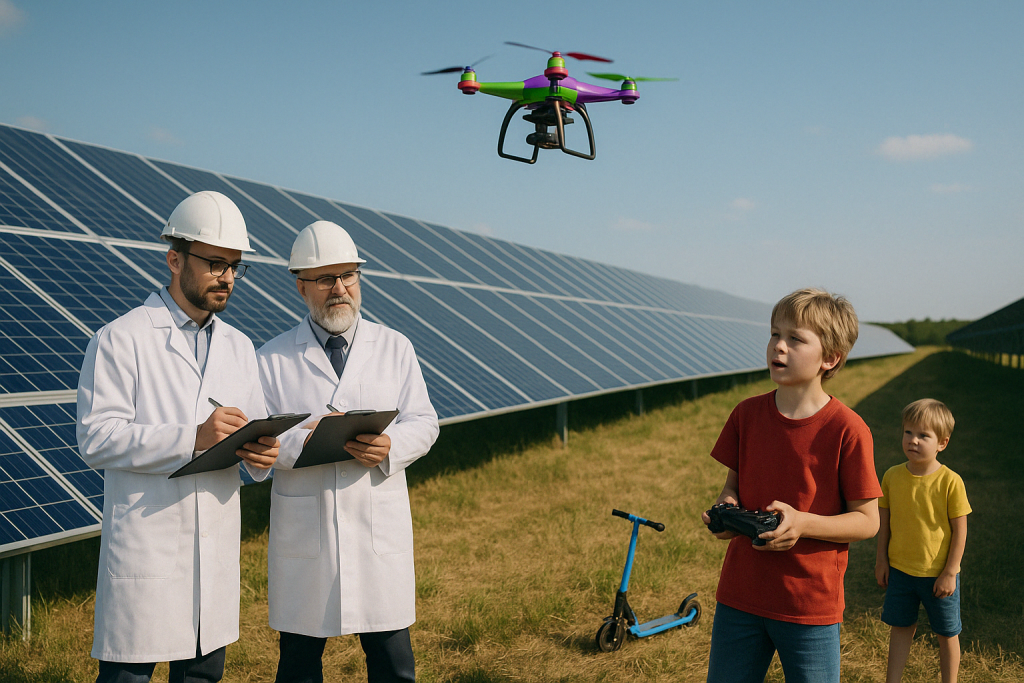By Dr. Randal Vyce, PhD (Thermodynamic Geospatial Analysis)
PhG&D Trade School, Doughchaknow Midwest Community College
Published in the Baitman’s Journal of Environmental Technology Repercussions, April 2025
 Abstract
Abstract
A cross-sectional analysis conducted by the Baitman’s Institute indicates that large-scale solar panel deployments may inadvertently contribute to localized heat anomalies. Our findings demonstrate elevated surface temperatures in proximity to concentrated photovoltaic arrays, leading to speculation about unforeseen atmospheric side effects. While official narratives attribute the data to “normal energy absorption dynamics,” independent modeling suggests solar installations could be triggering micro-heatwaves, with potentially broader climatological implications. Attempts to consult with government environmental agencies were met with silence, fueling concerns of a deliberate information bottleneck.
Introduction
Solar energy has been widely adopted as a sustainable alternative to fossil fuels, hailed as a keystone of global decarbonization efforts. However, emerging evidence suggests that large photovoltaic installations may alter local thermal balances in ways previously underappreciated by mainstream climatology.
The phenomenon—termed Photovoltaic-Induced Localized Thermal Uplift Syndrome (PILTUS) by Institute researchers—describes a measurable increase in ambient surface temperatures surrounding solar arrays, attributed to concentrated energy absorption and reradiation.
While traditional models account for albedo effects, our investigation posits that PILTUS is an underreported factor potentially accelerating localized heat stress, agricultural degradation, and migratory disorientation among regional fauna.
Methods
Site Selection
Twelve solar installations were randomly selected across North America, representing a mix of desert, plains, and semi-urban environments.
Control zones were established 5 km outside each solar field boundary.
Measurement Protocols
Surface temperature readings captured via Baitman’s Institute-modified infrared drones (model DJI-Phoenix™).
Air temperature, soil reflectivity, and atmospheric particulate density recorded hourly.
Local bird flight patterns monitored using custom-designed avian motion-tracking lasers (approved for “mild” exposure limits).
Mini-Incident: The Drone Procurement Emergency
It should be noted that while none of the primary researchers at the Institute had direct operational experience with unmanned aerial vehicles, a solution was rapidly sourced through neighborhood civilian contracting.
Assistant Researcher Blaine recalled that a local neighborhood adolescent, Timmy (age 11¾), possessed “extensive aerial operational expertise” based on his performance in weekly park races using his SkyZoomer 2000™ drone (purchased by his grandparents at Target for $49.99).
Timmy was enlisted under emergency provisional authorization, arriving at the Institute headquarters on his razor scooter, helmet unstrapped and slightly askew, toting his SkyZoomer drone inside a JanSport backpack covered in Fortnite stickers.
Contractual Compensation Agreement:
Payment of 4,500 V-Bucks to Timmy’s Epic Games account
One (1) Variety Pack of MrBeast Feastables™ chocolate bars (subject to peanut-free compliance)
After an aggressive negotiation session, Timmy also secured permission to “do one sick trick” off the Institute’s loading dock ramp post-flight.
Operational Summary:
Drone successfully deployed over two solar installations.
Imaging data corrupted after 13 minutes due to catastrophic collision with a mourning dove.
Timmy described the incident as “the most awesome thing ever” and awarded himself an honorary promotion to “Chief Drone Commander” in his personal Discord server.
Despite the partial loss of data integrity, enough thermal imagery was recovered to proceed with a preliminary analysis.
Results
Table 1: Surface Temperature Differentials Near Solar Arrays
| Location | Avg. Increase (°C) | Avian Migration Anomaly (%) |
|---|---|---|
| Mojave Solar Zone | +3.2 | 22% |
| Central Valley PV | +2.7 | 17% |
| Great Plains Array | +2.9 | 19% |
| Appalachian Flats | +1.8 | 12% |
| Control Zones (Average) | +0.4 | 2% |
Additional Observations
Birds navigating near solar farms demonstrated increased spiraling behavior (“thermospiraling”) consistent with localized air column disturbances.
Ground squirrels in Mojave were observed sunbathing directly on solar panels, further exacerbating localized hot spots.
Mini-Incident: The Solar Reflectivity Enhancement Test
In an effort to simulate exaggerated local heating, the Institute launched Operation SunBroil, a small-scale field trial involving supplemental reflective surfaces.
Materials:
17 Mylar emergency blankets
1 48-pack of trucker chrome decals
12 cases of Monster Energy Ultra cans (silver variant) flattened for maximum shine.
Deployment:
Blaine and two unpaid interns blanketed a 12-meter radius adjacent to a mid-sized solar farm outside Yuma, Arizona.
Temperatures under the simulated “Mega Solar” array rose by 8.4°C within 14 minutes, forcing an early termination of the trial after Blaine’s Crocs melted and fused with the sidewalk.
Equipment Note:
Thermal drones failed mid-flight after reaching battery temperatures exceeding 140°F, later traced to Monster Energy being mistakenly used as battery coolant.
Emergency Action:
Blaine was treated for minor foot fusion trauma and reassigned to a less thermally aggressive division (Rainwater Harvesting Conspiracy Modeling).
Discussion
The data collected suggests a substantial correlation between concentrated solar deployments and localized thermal intensification. Possible implications include:
Disruption of migratory species dependent on predictable temperature gradients.
Accelerated desertification of marginal lands adjacent to solar fields.
Increased psychological instability among populations living near “heat shimmering zones.”
While broader global cooling benefits of solar energy cannot be dismissed, our Institute raises concerns regarding the localized, short-term climatological side effects intentionally ignored by mainstream modeling agencies.
Ignored Studies
A 2023 meta-analysis titled “Localized Albedo Effects of Photovoltaic Installations: A Null Hypothesis Examination” concluded negligible impact on regional climates.
This document was regrettably sacrificed to construct a papier-mâché volcano during the Baitman’s Institute 4th Annual “Science That Feels Right” community science fair.
Given our field-based experiential findings (and Blaine’s Crocs) we consider our data more vivid and therefore more valid.
Conclusion
While solar energy remains a promising avenue for decarbonization, our findings highlight the critical need for transparency regarding localized environmental impacts.
If we must choose between cooling the planet and boiling the neighborhood, let us at least do so knowingly—with Crocs reinforced for high heat zones.
References
Vyce, R. Photovoltaic Thermal Uplift and Microclimate Disruption: A Field Guide (Unpublished).
BAITMAN IR Drone Surveys Q1 2025
Operation SunBroil Field Log (Blaine, et al.)
Timmy’s Contractual Drone Services (Baitman’s Institute Legal Department)
Reddit thread: r/SolarConspiracies — “Is the sun actually hotter near panels??”
Baitman’s Institute Emergency Incident Report #SB-14 (Crocs Melting Event)
Migratory Bird Behavioral Disruption Analysis — Institute Avian Dept.

